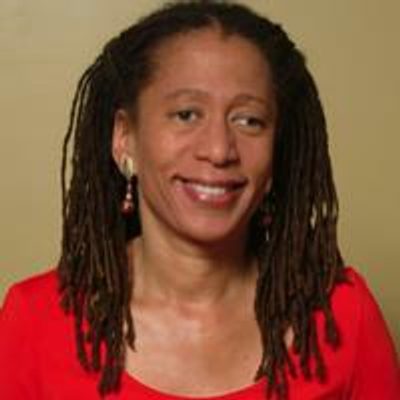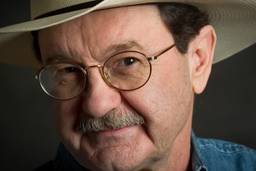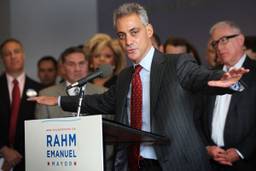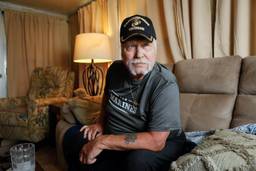Obama’s Chicago: A Pre-NATO Summit Primer
Why the president’s decision to ‘come home in Chicago’ nearly 30 years ago was so shrewd.
Laura S. Washington
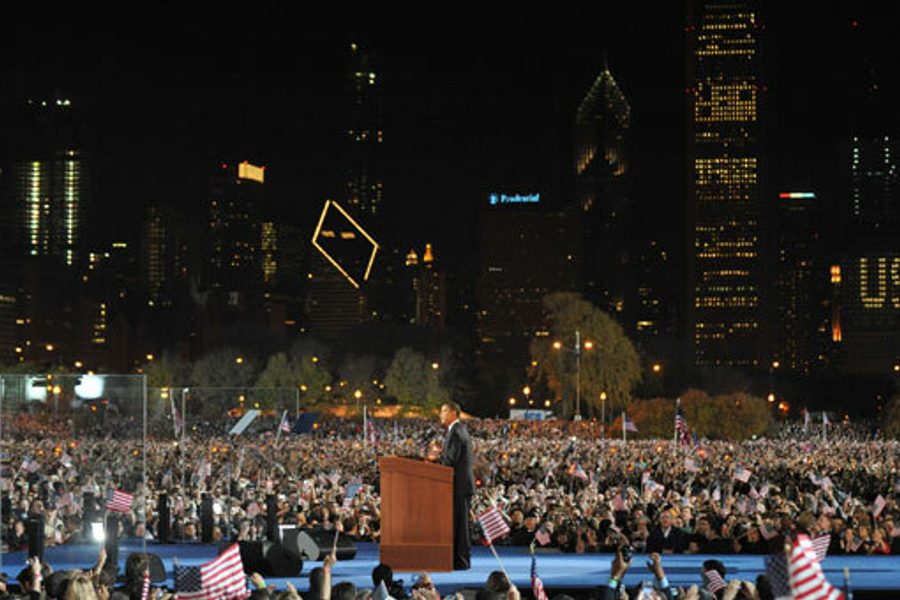
He was the nobody that nobody sent.
Barack Obama’s choice of Chicago as his political and psychic home seems brilliant in retrospect. Yet in many ways, it was an unlikely launching pad for America’s first black president.
Brought up in Hawaii and Indonesia, Obama was a stranger to Chicago powers large and small. The big city in the nation’s heartland has always played second string to the glittering coasts. Until Obama, it was best known as the home of mobsters, racial warfare, and hardball politics. The regular Democratic Party ran the show, with a bruising and often wayward iron fist. It is said to be America’s most corrupt city.
In the mid-1980s, Obama arrived in Chicago, testing the famous tale from his eventual political mentor, Abner Mikva, a longtime congressman from Hyde Park and the city’s North Shore.
In a 2008 New Yorker interview, Mikva recalled his first attempt to volunteer for the Democratic Party. At the party headquarters, Mikva recalled, a “ward boss came in and pulled the cigar out of his mouth and said, ‘Who sent you?’ And I said, ‘Nobody sent me.’ He put the cigar back in his mouth and said, ‘We don’t want nobody nobody sent.’ “
In 2012, Barack Obama is no longer a nobody. This week, he will return home to his old stomping grounds to host the NATO summit (and probably stop by his re-election campaign headquarters). As Chicago takes the world stage, here are some insights about the city that molded him.
Chicago’s historic trilogy
Obama’s choice of Chicago was not accidental, but shrewd. He once told his neighborhood newspaper, the Hyde Park Herald: “I came home in Chicago.” “Home” represented a rare but robust combination of progressive activism, sustaining black power and old fashioned, Democratic Party clout.
The president’s coming of age in Chicago completed the city’s historic black trilogy: DuSable, Washington and Obama. Around 1779, a French-Haitian fur trader, Jean Baptiste Point DuSable, encamped at the southern tip of Lake Michigan, becoming Chicago’s “founding father.” In 1983, Harold Washington won a hard-fought election to become the city’s first African American mayor. His victory blasted the Democratic Machine with a brand of progressive politics that brought together a progressive coalition of blacks, Latinos, liberal whites, women and gays.
Before Washington, party regulars co-opted minority politicians and voters and kept them in line with patronage jobs and contracts, but gave them little authentic power. Timuel Black, the esteemed professor emeritus and dean of black progressives, dubbed it “Plantation Politics.”
In 1985 Obama was drawn to Chicago by Washington’s progressive politics. Like Washington, Obama assiduously worked on coalition building, and eventually brought longtime Mayor and Chicago “boss’ Richard M. Daley, other Democratic Party regulars, and even Republicans into his fold.
But first, the freshly minted graduate of Columbia University would dig into grassroots community organizing.
A careful ascension
In the 1930s, Saul Alinsky, the author of the organizing bible, Rules for Radicals, was a gritty populist-intellectual who built a lasting brand of power out of Back of the Yards, a gritty, working class enclave on Chicago’s Southwest Side.
Obama learned the Alinsky way. He was the first executive director of the Developing Communities Project, which mobilizes citizens for change through local churches and community based organizations. In the 1980s the group was working on environmental justice and other causes out of a Chicago bungalow in Roseland on the far South Side.
Obama spent only three years honing his organizing chops, but the experience lent abundant street cred for his presidential campaign mantra of “Change.”
Obama and other community advocates fought for the removal of asbestos from Altgeld Gardens, a depressed public housing project on the far Southeast Side. One resident of the ironically named “Gardens” was Hazel Johnson, a determined mother and activist who founded People for Community Recovery, a pioneer in the environmental justice movement.
Today, the Developing Communities Project is spearheading a campaign to extend a major rail line through Roseland and other neglected neighborhoods.
Altgeld Gardens was symbolic of the decline of public housing. The massive, racially and economically segregated “projects” has become ugly symbols of pernicious poverty, dysfunction and crime. The city’s Plan for Transformation, the city’s closely-watched $1.6 billion rehabilitation program launched in 2000, promised to change that. Touted as a national model for remaking federally funded housing for the poor, the plan has been controversial. In February 2012 Mayor Rahm Emanuel announced plans for a major “recalibration” of the effort.
After his organizing stint, Obama was off to Harvard Law School, where he excelled and established his academic pedigree. In 1991 he returned to Chicago and settled in Hyde Park. While Chicago remains one of America’s most segregated cities, Hyde Park was the integrated oasis for progressive intellectuals, activists and professionals.
The neighborhood has been the hallowed stomping ground of myriad movers and shakers, among them boxing champion Muhammad Ali; the University of Chicago and academic icons like Enrico Fermi and Saul Bellow; Gospel songbird Mahalia Jackson; Nation of Islam leader Louis Farrakhan; Bill Veeck, the wily White Sox owner; and Hugh Hefner, the ultimate Playboy.
Obama was a lecturer at the university’s law school, wife Michelle a top executive at its medical center, and his children attended its Lab School. Obama’s early political career was plotted at kitchen tables throughout the neighborhood.
In 1992, Obama ran Project Vote, a voter registration campaign that helped elect President Bill Clinton and elevate Carol Moseley Braun as the first African-American woman elected to the U.S. Senate. The political work connected him to the city’s political elites, wealthy donors and political gurus like Mikva and David Axelrod.
Chicago is the nation’s capital of the black middle class. Michelle Obama, whom he met while they worked together at a law firm, helped him maneuver that world. She worked in government and community circles, ran the Chicago chapter of Public Allies, an AmeriCorps youth service program, and was an attorney in the city’s Law Department.
The South Side native and Harvard Law graduate connected her husband to prominent black professionals like Valerie Jarrett, now his closest White House confidante; Martin Nesbitt, a best friend who runs an airport parking business; and John Rogers Jr., an Obama basketball buddy and CEO of an investment company. Such relationships helped the future president plumb a lucrative fundraising and support network.
The church is the black community’s strongest institution. Obama tapped into its allure when he joined Trinity United Church of Christ, a prominent congregation on West 95th Street. Its formidable pastor, the Rev. Jeremiah Wright, preached a black liberation Christian theology that promoted social justice and activism. Wright and other Obama allies like the Catholic priest, Rev. Michael Pfleger, and longtime civil rights champion Rev. Jesse Jackson Sr., would become flashpoints in the 2008 presidential campaign. But the social justice institutions they molded, like the Faith Community of St. Sabina and Rainbow PUSH, remain influential forces. In January, Trinity kicked off plans for Imani Village, a 27-acre community-based conglomerate of sustainable housing, urban farming, retail stores, health centers and a sports complex.
The city’s black church scene staged musical talent that set the sanctuaries rocking. Chicago artists with deep Gospel roots include Mahalia Jackson, the bandleader Tommy Dorsey, and Mavis Staples, the hit soloist and mainstay of the Staples Singers. Her swinging, “I’ll TakeYou There” was a theme song for Obama’s presidential campaign. Dorsey was the choir director at Pilgrim Baptist Church, the Adler and Sullivan-designed structure that was nearly destroyed in a 2006 fire. Plans are underway to revive the architectural gem.
South Side pride, and power
In 2002, his bond with the city’s white progressives brought Obama to a rally at the Federal Plaza downtown. At the protest, mounted by Chicagoans Against the War in Iraq, Obama delivered a speech that sealed his anti-war credentials, and another crucial plank in his presidential campaign.
Obama’s Hawaiian genes may have helped Obama surf the treacherous waters of regular, black and independent politics. His allies included his “political Godfather,” now-retired State Senate President Emil Jones, a Machine stalwart; to progressive white and black independents like Mikva and Obama’s former alderman and now Cook County Board President Toni Preckwinkle; to black nationalists like Louis Farrakhan.
Like most every South Sider, Obama is an avowed White Sox fan. During the 2008 election, he mocked the rival Chicago Cubs and their pastoral Wrigley Field. “You go to Wrigley Field, you have a beer, beautiful people up there. People aren’t watching the game,” he told ESPN in 2008. “It’s not serious. White Sox, that’s baseball. South Side.”
Them’s fightin’ words in Chicago. During the NATO/G8 summit weekend, the Cubs will take on the Sox – at Wrigley Field.
Nestled between Hyde Park and McCormick Place sits Bronzeville, the historic heart of black Chicago. Once known as the “Black Belt,” it was the port of entry for the Great Back Migration from the South in the first half of the 20th Century. Once a segregated but vibrant haven for black Chicago, the area declined, but is reemerging as a symbol of black progress and tourist destination.
Obama co-founded Bronzeville’s Lugenia Burns Hope Center, a leadership development and organizing institute. A current Hope Center project is Housing Bronzeville, which works to protect affordable housing in the midst of the ongoing foreclosure epidemic.
Bronzeville boosters are pushing the area as a potential location for a future Obama Presidential Library; they’ll get plenty of competition from the University of Chicago. (In 2013, presidential advisor David Axelrod will launch an Institute of Politics at the U of C).
Obama cultivated the city’s multitudinous ethnic groups. According to a new director from Chicago Area Ethnic Resources, the region boasts 245 ethnic organizations spanning 57 ethnicities, and 68 ethnic media outlets. Black and ethnic media outlets who have chronicled Obama’s Chicago include Johnson Publications’ Ebony and Jet, run by former White House Social Director Desiree Rogers, the 106-year-old Chicago Defender, and LaRaza.
But Obama’s Chicago morphed into Rahm’s Chicago. In February 2011, Rahm Emanuel was elected mayor in Chicago after a 21-year Daley reign. Emanuel, Obama’s former White House chief of staff, got a lot of help from his old friend.
Emanuel, a centrist Democrat who favors power over ideology, has quickly established himself as the indisputable new boss of Chicago. And the ferociously putative “Rhambo” may be eyeing a bigger prize. Progressives, beware: Emanuel could be in training for a 2016 presidential bid.
